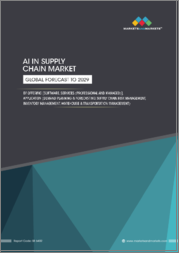
|
시장보고서
상품코드
1721316
세계의 수요 계획 솔루션 시장 조사 보고서 : 산업 분석, 규모, 점유율, 성장, 동향, 예측(2025-2033년)Global Demand Planning Solutions Market Research Report- Industry Analysis, Size, Share, Growth, Trends and Forecast 2025 to 2033 |
||||||
세계의 수요 계획 솔루션 시장 규모는 2024년 55억 1,000만 달러에서 2033년에는 135억 5,000만 달러로 성장할 것으로 예측되며, 2026-2033년의 예측 기간 중 연평균 성장률(CAGR)은 10.52%로 견고한 성장을 보일 전망입니다.
수요 계획 솔루션 시장은 공급망 운영의 최적화와 예측 정확도 향상을 목표로 하는 기업이 증가함에 따라 견고한 성장세를 보일 것으로 예측됩니다. 수요 계획 솔루션은 기업이 과거 데이터, 시장 동향, 고객 행동을 분석하여 제품 및 서비스에 대한 미래 수요를 예측할 수 있게 해줍니다. 효율적인 재고 관리와 고객 만족에 대한 필요성이 증가함에 따라 수요 계획 기술의 채택이 급증할 것으로 예측됩니다. 머신러닝, 인공지능, 데이터 분석의 혁신은 수요 계획 솔루션의 기능을 강화하여 최신 공급망 관리에 필수적인 툴이 되고 있습니다.
또한 공급망 운영의 민첩성과 반응성에 대한 중요성이 높아지면서 변화하는 시장 환경에 적응할 수 있는 수요 계획 솔루션에 대한 수요가 증가하고 있습니다. 기업이 재고 부족과 과잉 재고를 최소화하기 위해 노력하는 가운데, 실시간 인사이트를 제공하는 고급 예측 툴에 대한 수요는 계속 증가할 것으로 보입니다. 이러한 추세는 시장 혁신을 촉진하고, 정확도 향상, 협업, 다른 공급망 시스템과의 통합을 제공하는 수요 계획 솔루션의 개발로 이어질 것으로 예측됩니다.
또한 E-Commerce의 부상과 세계 공급망의 복잡성은 수요 계획 솔루션 시장을 더욱 촉진할 것으로 예측됩니다. 기업이 온라인 소매 및 국제 물류의 과제를 극복함에 따라 수요 계획 프로세스를 효과적으로 관리하고 최적화할 수 있는 솔루션에 대한 수요가 증가할 것입니다. 보다 역동적이고 상호 연결된 공급망 운영으로의 전환은 수요 계획 기술에 대한 투자를 촉진하고 이 시장의 소프트웨어 공급업체와 컨설턴트에게 새로운 비즈니스 기회를 제공할 것으로 보입니다. 수요 계획 솔루션 시장의 미래는 다양한 산업에서 효율성, 정확성 및 대응력을 향상시키는 지속적인 발전이 특징입니다.
당사의 보고서는 고객에게 다양한 산업 및 시장에 대한 종합적이고 실용적인 인사이트를 제공하기 위해 세심하게 작성되었습니다. 각 보고서는 시장 상황을 완전히 이해하기 위해 몇 가지 중요한 요소를 포함하고 있습니다.
시장 개요: 시장 개요: 정의, 분류, 산업 현황에 대한 개요 등 시장에 대한 자세한 소개.
시장 성장 촉진요인 : 시장 성장에 영향을 미치는 주요 촉진요인, 억제요인, 시장 성장 촉진요인 및 과제를 상세하게 분석합니다. 이 섹션에서는 기술 발전, 규제 변화, 새로운 동향 등의 요인을 검토합니다.
세분화 분석 : 제품 유형, 애플리케이션, 최종사용자, 지역 등의 기준에 따라 시장을 명확한 부문으로 분류합니다. 이 분석을 통해 각 부문의 성과와 잠재력을 파악할 수 있습니다.
경쟁 환경: 시장 점유율, 제품 포트폴리오, 전략적 구상, 재무 실적 등 주요 시장 기업에 대한 종합적인 평가. 주요 기업이 채택하고 있는 경쟁 역학 및 주요 전략에 대한 인사이트을 제공합니다.
시장 예측 : 과거 데이터와 현재 시장 상황을 바탕으로 일정 기간 중 시장 규모와 성장 추세를 예측합니다. 여기에는 정량적 분석과 미래 시장 궤적을 보여주는 그래프 표시가 포함됩니다.
지역 분석 : 지역별 시장 성과를 평가하고 주요 시장 및 지역 동향을 파악할 수 있습니다. 지역 시장 역학 및 비즈니스 기회를 이해하는 데 도움이 됩니다.
새로운 동향과 기회 : 현재 시장 동향과 새로운 시장 동향, 기술 혁신, 잠재적 투자 대상 분야를 파악합니다. 미래 시장 개발 및 성장 전망에 대한 인사이트를 제공합니다.
목차
제1장 서문
제2장 개요
- 시장의 하이라이트
- 세계 시장 스냅숏
제3장 수요 계획 솔루션 산업 분석
- 서론 : 시장 역학
- 시장 성장 촉진요인
- 시장 성장 억제요인
- 기회
- 업계 동향
- Porter's Five Forces 분석
- 시장의 매력 분석
제4장 밸류체인 분석
- 밸류체인 분석
- 원재료 분석
- 원재료 리스트
- 원재료 제조업체 리스트
- 주요 원재료의 가격 동향
- 잠재적 바이어 리스트
- 마케팅 채널
- 다이렉트 마케팅
- 인다이렉트 마케팅
- 마케팅 채널 발전 동향
제5장 세계의 수요 계획 솔루션 시장 분석 : 컴포넌트별
- 개요 : 컴포넌트별
- 실적·예측 데이터 분석 : 컴포넌트별
- 소프트웨어/플랫폼
- 서비스
제6장 세계의 수요 계획 솔루션 시장 분석 : 배포별
- 개요 : 배포별
- 실적·예측 데이터 분석 : 배포별
- 온프레미스
- 클라우드 기반
제7장 세계의 수요 계획 솔루션 시장 분석 : 기업 규모별
- 개요 : 기업 규모별
- 실적·예측 데이터 분석 : 기업 규모별
- 중소기업
- 대기업
제8장 세계의 수요 계획 솔루션 시장 분석 : 산업별
- 개요 : 산업별
- 실적·예측 데이터 분석 : 산업별
- BFSI
- IT·통신
- 헬스케어
- 소매·E-Commerce
- 자동차
- 식품 및 음료
- 제조
- 접객(Hoapitality)
- 기타
제9장 세계의 수요 계획 솔루션 시장 분석 : 지역별
- 지역별 전망
- 서론
- 북미의 판매 분석
- 개요, 실적과 예측
- 북미 : 부문별
- 북미 : 국가별
- 미국
- 캐나다
- 멕시코
- 유럽의 판매 분석
- 개요, 실적과 예측
- 유럽 : 부문별
- 유럽 : 국가별
- 영국
- 프랑스
- 독일
- 이탈리아
- 러시아
- 기타 유럽
- 아시아태평양의 판매 분석
- 개요, 실적과 예측
- 아시아태평양 : 부문별
- 아시아태평양 : 국가별
- 중국
- 인도
- 일본
- 한국
- 호주
- 동남아시아
- 기타 아시아태평양
- 라틴아메리카의 판매 분석
- 개요, 실적과 예측
- 라틴아메리카 : 부문별
- 라틴아메리카 : 국가별
- 브라질
- 아르헨티나
- 페루
- 칠레
- 기타 라틴아메리카
- 중동 및 아프리카의 판매 분석
- 개요, 실적과 예측
- 중동 및 아프리카 : 부문별
- 중동 및 아프리카 : 국가별
- 사우디아라비아
- 아랍에미리트
- 이스라엘
- 남아프리카공화국
- 기타 중동 및 아프리카
제10장 수요 계획 솔루션 기업의 경쟁 구도
- 수요 계획 솔루션 시장의 경쟁
- 제휴·협력·합의
- 합병·인수
- 신제품 발매
- 기타 개발
제11장 기업 개요
- 상위 기업의 시장 점유율 분석
- 시장 집중도
- SAP SE
- International Business Machines Corporation
- Cognizant Technology Solutions Corp
- Oracle Corporation(Demantra)
- Logility Inc.
- Relex Oy
- Gainsystems Inc.
- Demand Works Company
- Blue Ridge Solutions Inc.
- John Galt Solutions Inc.
- Avercast LLC.
- Alloy Technologies Inc.
- MRPeasy
- Netstock Operations Limited
- Syncron AB
Global Demand Planning Solutions Market size is anticipated to grow from USD 5.51 Billion in 2024 to USD 13.55 Billion by 2033, showcasing a robust Compound Annual Growth Rate (CAGR) of 10.52% during the forecast period of 2026 to 2033.
The demand planning solutions market is set to experience robust growth as organizations increasingly seek to optimize their supply chain operations and improve forecasting accuracy. Demand planning solutions enable businesses to analyze historical data, market trends, and customer behavior to predict future demand for products and services. As the need for efficient inventory management and customer satisfaction rises, the adoption of demand planning technologies is expected to surge. Innovations in machine learning, artificial intelligence, and data analytics are enhancing the capabilities of demand planning solutions, making them essential tools for modern supply chain management.
Moreover, the growing emphasis on agility and responsiveness in supply chain operations is driving the demand for demand planning solutions that can adapt to changing market conditions. As organizations strive to minimize stockouts and excess inventory, the need for advanced forecasting tools that provide real-time insights will continue to grow. This trend is expected to foster innovation in the market, leading to the development of demand planning solutions that offer enhanced accuracy, collaboration, and integration with other supply chain systems.
Additionally, the rise of e-commerce and the increasing complexity of global supply chains are anticipated to further propel the demand planning solutions market. As businesses navigate the challenges of online retail and international logistics, the demand for solutions that can effectively manage and optimize demand planning processes will increase. This shift towards more dynamic and interconnected supply chain operations will drive investments in demand planning technologies, creating new opportunities for software providers and consultants in the market. The future of the demand planning solutions market is characterized by continuous advancements that enhance efficiency, accuracy, and responsiveness across diverse industries.
Our reports are meticulously crafted to provide clients with comprehensive and actionable insights into various industries and markets. Each report encompasses several critical components to ensure a thorough understanding of the market landscape:
Market Overview: A detailed introduction to the market, including definitions, classifications, and an overview of the industry's current state.
Market Dynamics: In-depth analysis of key drivers, restraints, opportunities, and challenges influencing market growth. This section examines factors such as technological advancements, regulatory changes, and emerging trends.
Segmentation Analysis: Breakdown of the market into distinct segments based on criteria like product type, application, end-user, and geography. This analysis highlights the performance and potential of each segment.
Competitive Landscape: Comprehensive assessment of major market players, including their market share, product portfolio, strategic initiatives, and financial performance. This section provides insights into the competitive dynamics and key strategies adopted by leading companies.
Market Forecast: Projections of market size and growth trends over a specified period, based on historical data and current market conditions. This includes quantitative analyses and graphical representations to illustrate future market trajectories.
Regional Analysis: Evaluation of market performance across different geographical regions, identifying key markets and regional trends. This helps in understanding regional market dynamics and opportunities.
Emerging Trends and Opportunities: Identification of current and emerging market trends, technological innovations, and potential areas for investment. This section offers insights into future market developments and growth prospects.
SEGMENTATION COVERED IN THE REPORT
By Component
- Software/Platform
- Services
By Deployment
- On-premise
- Cloud-based
By Enterprise Size
- Small & Medium Enterprises
- Large Enterprises
By Industry
- BFSI
- IT & Telecom
- Healthcare
- Retail & e-Commerce
- Automotive
- Food & Beverages
- Manufacturing
- Hospitality
- Others
- COMPANIES PROFILED
- SAP SE
- International Business Machines Corporation
- Cognizant Technology Solutions Corp
- Oracle Corporation (Demantra)
- Logility Inc.
- Relex Oy
- Gainsystems Inc.
- Demand Works Company
- Blue Ridge Solutions Inc.
- John Galt Solutions Inc.
- Avercast LLC.
- Alloy Technologies Inc.
- MRPeasy
- Netstock Operations limited
- Syncron AB.
- The above list can be customized.
TABLE OF CONTENTS
1. PREFACE
- 1.1. Report Description
- 1.1.1 Objective
- 1.1.2 Target Audience
- 1.1.3 Unique Selling Proposition (USP) & offerings
- 1.2. Research Scope
- 1.3. Research Methodology
- 1.3.1 Market Research Process
- 1.3.2 Market Research Methodology
2. EXECUTIVE SUMMARY
- 2.1. Highlights of Market
- 2.2. Global Market Snapshot
3. DEMAND PLANNING SOLUTIONS INDUSTRY ANALYSIS
- 3.1. Introduction - Market Dynamics
- 3.2. Market Drivers
- 3.3. Market Restraints
- 3.4. Opportunities
- 3.5. Industry Trends
- 3.6. Poerter's Five Force Analysis
- 3.7. Market Attractiveness Analysis
- 3.7.1 Market Attractiveness Analysis By Component
- 3.7.2 Market Attractiveness Analysis By Deployment
- 3.7.3 Market Attractiveness Analysis By Enterprise Size
- 3.7.4 Market Attractiveness Analysis By Industry
- 3.7.5 Market Attractiveness Analysis By Region
4. VALUE CHAIN ANALYSIS
- 4.1. Value Chain Analysis
- 4.2. Raw Material Analysis
- 4.2.1 List of Raw Materials
- 4.2.2 Raw Material Manufactures List
- 4.2.3 Price Trend of Key Raw Materials
- 4.3. List of Potential Buyers
- 4.4. Marketing Channel
- 4.4.1 Direct Marketing
- 4.4.2 Indirect Marketing
- 4.4.3 Marketing Channel Development Trend
5. GLOBAL DEMAND PLANNING SOLUTIONS MARKET ANALYSIS BY COMPONENT
- 5.1. Overview By Component
- 5.2. Historical and Forecast Data Analysis By Component
- 5.3. Software/Platform Historic and Forecast Sales By Regions
- 5.4. Services Historic and Forecast Sales By Regions
6. GLOBAL DEMAND PLANNING SOLUTIONS MARKET ANALYSIS BY DEPLOYMENT
- 6.1. Overview By Deployment
- 6.2. Historical and Forecast Data Analysis By Deployment
- 6.3. On-premise Historic and Forecast Sales By Regions
- 6.4. Cloud-based Historic and Forecast Sales By Regions
7. GLOBAL DEMAND PLANNING SOLUTIONS MARKET ANALYSIS BY ENTERPRISE SIZE
- 7.1. Overview By Enterprise Size
- 7.2. Historical and Forecast Data Analysis By Enterprise Size
- 7.3. Small & Medium Enterprises Historic and Forecast Sales By Regions
- 7.4. Large Enterprises Historic and Forecast Sales By Regions
8. GLOBAL DEMAND PLANNING SOLUTIONS MARKET ANALYSIS BY INDUSTRY
- 8.1. Overview By Industry
- 8.2. Historical and Forecast Data Analysis By Industry
- 8.3. BFSI Historic and Forecast Sales By Regions
- 8.4. IT & Telecom Historic and Forecast Sales By Regions
- 8.5. Healthcare Historic and Forecast Sales By Regions
- 8.6. Retail & e-Commerce Historic and Forecast Sales By Regions
- 8.7. Automotive Historic and Forecast Sales By Regions
- 8.8. Food & Beverages Historic and Forecast Sales By Regions
- 8.9. Manufacturing Historic and Forecast Sales By Regions
- 8.10. Hospitality Historic and Forecast Sales By Regions
- 8.11. Others Historic and Forecast Sales By Regions
9. GLOBAL DEMAND PLANNING SOLUTIONS MARKET ANALYSIS BY GEOGRAPHY
- 9.1. Regional Outlook
- 9.2. Introduction
- 9.3. North America Sales Analysis
- 9.3.1 Overview, Historic and Forecast Data Sales Analysis
- 9.3.2 North America By Segment Sales Analysis
- 9.3.3 North America By Country Sales Analysis
- 9.3.4 United States Sales Analysis
- 9.3.5 Canada Sales Analysis
- 9.3.6 Mexico Sales Analysis
- 9.4. Europe Sales Analysis
- 9.4.1 Overview, Historic and Forecast Data Sales Analysis
- 9.4.2 Europe By Segment Sales Analysis
- 9.4.3 Europe By Country Sales Analysis
- 9.4.4 United Kingdom Sales Analysis
- 9.4.5 France Sales Analysis
- 9.4.6 Germany Sales Analysis
- 9.4.7 Italy Sales Analysis
- 9.4.8 Russia Sales Analysis
- 9.4.9 Rest Of Europe Sales Analysis
- 9.5. Asia Pacific Sales Analysis
- 9.5.1 Overview, Historic and Forecast Data Sales Analysis
- 9.5.2 Asia Pacific By Segment Sales Analysis
- 9.5.3 Asia Pacific By Country Sales Analysis
- 9.5.4 China Sales Analysis
- 9.5.5 India Sales Analysis
- 9.5.6 Japan Sales Analysis
- 9.5.7 South Korea Sales Analysis
- 9.5.8 Australia Sales Analysis
- 9.5.9 South East Asia Sales Analysis
- 9.5.10 Rest Of Asia Pacific Sales Analysis
- 9.6. Latin America Sales Analysis
- 9.6.1 Overview, Historic and Forecast Data Sales Analysis
- 9.6.2 Latin America By Segment Sales Analysis
- 9.6.3 Latin America By Country Sales Analysis
- 9.6.4 Brazil Sales Analysis
- 9.6.5 Argentina Sales Analysis
- 9.6.6 Peru Sales Analysis
- 9.6.7 Chile Sales Analysis
- 9.6.8 Rest of Latin America Sales Analysis
- 9.7. Middle East & Africa Sales Analysis
- 9.7.1 Overview, Historic and Forecast Data Sales Analysis
- 9.7.2 Middle East & Africa By Segment Sales Analysis
- 9.7.3 Middle East & Africa By Country Sales Analysis
- 9.7.4 Saudi Arabia Sales Analysis
- 9.7.5 UAE Sales Analysis
- 9.7.6 Israel Sales Analysis
- 9.7.7 South Africa Sales Analysis
- 9.7.8 Rest Of Middle East And Africa Sales Analysis
10. COMPETITIVE LANDSCAPE OF THE DEMAND PLANNING SOLUTIONS COMPANIES
- 10.1. Demand Planning Solutions Market Competition
- 10.2. Partnership/Collaboration/Agreement
- 10.3. Merger And Acquisitions
- 10.4. New Product Launch
- 10.5. Other Developments
11. COMPANY PROFILES OF DEMAND PLANNING SOLUTIONS INDUSTRY
- 11.1. Top Companies Market Share Analysis
- 11.2. Market Concentration Rate
- 11.3. SAP SE
- 11.3.1 Company Overview
- 11.3.2 Company Revenue
- 11.3.3 Products
- 11.3.4 Recent Developments
- 11.4. International Business Machines Corporation
- 11.4.1 Company Overview
- 11.4.2 Company Revenue
- 11.4.3 Products
- 11.4.4 Recent Developments
- 11.5. Cognizant Technology Solutions Corp
- 11.5.1 Company Overview
- 11.5.2 Company Revenue
- 11.5.3 Products
- 11.5.4 Recent Developments
- 11.6. Oracle Corporation (Demantra)
- 11.6.1 Company Overview
- 11.6.2 Company Revenue
- 11.6.3 Products
- 11.6.4 Recent Developments
- 11.7. Logility Inc.
- 11.7.1 Company Overview
- 11.7.2 Company Revenue
- 11.7.3 Products
- 11.7.4 Recent Developments
- 11.8. Relex Oy
- 11.8.1 Company Overview
- 11.8.2 Company Revenue
- 11.8.3 Products
- 11.8.4 Recent Developments
- 11.9. Gainsystems Inc.
- 11.9.1 Company Overview
- 11.9.2 Company Revenue
- 11.9.3 Products
- 11.9.4 Recent Developments
- 11.10. Demand Works Company
- 11.10.1 Company Overview
- 11.10.2 Company Revenue
- 11.10.3 Products
- 11.10.4 Recent Developments
- 11.11. Blue Ridge Solutions Inc.
- 11.11.1 Company Overview
- 11.11.2 Company Revenue
- 11.11.3 Products
- 11.11.4 Recent Developments
- 11.12. John Galt Solutions Inc.
- 11.12.1 Company Overview
- 11.12.2 Company Revenue
- 11.12.3 Products
- 11.12.4 Recent Developments
- 11.13. Avercast LLC.
- 11.13.1 Company Overview
- 11.13.2 Company Revenue
- 11.13.3 Products
- 11.13.4 Recent Developments
- 11.14. Alloy Technologies Inc.
- 11.14.1 Company Overview
- 11.14.2 Company Revenue
- 11.14.3 Products
- 11.14.4 Recent Developments
- 11.15. MRPeasy
- 11.15.1 Company Overview
- 11.15.2 Company Revenue
- 11.15.3 Products
- 11.15.4 Recent Developments
- 11.16. Netstock Operations Limited
- 11.16.1 Company Overview
- 11.16.2 Company Revenue
- 11.16.3 Products
- 11.16.4 Recent Developments
- 11.17. Syncron AB
- 11.17.1 Company Overview
- 11.17.2 Company Revenue
- 11.17.3 Products
- 11.17.4 Recent Developments















